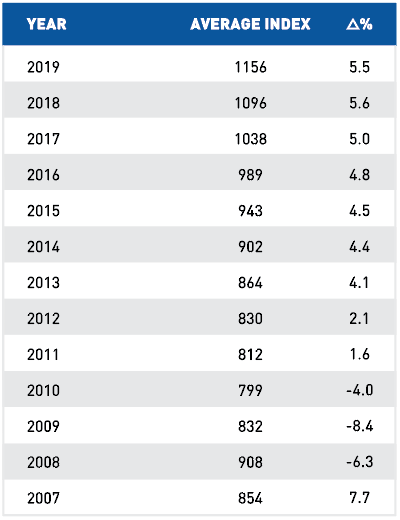Though the housing market remains strong, things have become tricky for investors. In early 2020, the U.S. inventory of homes plunged to the lowest level since 2012, according to the National Association of Realtors. As the graph below shows, the U.S. only has 3.1 months of supply, meaning it would take only 3.1 months to sell all the homes currently for sale. To put things in perspective, the historical average for house supply is about 6.0 months.
This creates challenges for real estate investors. Simply stated, low inventory leads to a low pool of investment opportunities. Even when a good deal arrives on the market, the lack of opportunity means many investors and residents will compete for that deal.
With high competition comes higher acquisition costs. Home prices have consistently reached all-time highs since 2012 and increased by 3.7 percent in 2019, according to CoreLogic data. That momentum is expected to continue in the next few years, with prices estimated to rise by 5.3 percent in 2020.
Rising construction costs further complicate the landscape. According to the Turner Building Cost Index, building costs increased by 44.7 percent in the 2010s, largely because material and labor shortages have driven up prices.
Consequently, real estate investors face more difficulty finding good deals, and that’s led to lower margins.
Now, you may be thinking: It is what it is. You can’t change the market.
That’s true. But you can make the market work for you.
To achieve greater success in this real estate market, get more active and be diligent when buying homes and making deals. With creativity and forward thinking, you can mitigate risks and ensure profitability.

The Turner Building Cost Index is determined by the following factors considered on a nationwide basis: labor rates and productivity, material prices and the competitive condition of the marketplace.
Be More Creative in Finding Yield
In today’s market, it takes hard work to source good deals. What you need is a direct-to-seller lead generation engine that balances traditional and digital marketing tactics. It’s the only way to generate a large number of transactions and scale your business. Some methods for direct-to-seller marketing in real estate include:
- Pay-per-click advertising and paid search marketing
- Paid social media marketing
- Text and email blasts
- Heavy outbound cold calling
- Direct mail
- Door knocking
- Driving-for-dollars
- Referral-based marketing plans
These direct-to-seller tactics will help you build awareness, increase engagement, and secure more prospective leads.
Be More Creative in Your Strategies
Since it’s hard to find good deals on fix-and-flip single-family homes, where is the opportunity?
Well, consider the current real estate market: we have low inventory, rising values, and low interest rates. Mortgage interest rates for a 15-year fixed loan have dropped to 2.96 percent, according to Bankrate (spring 2020).
Given these factors, we’ve seen a lot of investors look beyond single-family homes. Many top operators now seek opportunities in acquiring multifamily properties. Because of economies of scale within multifamily, you can acquire assets that generate more cashflow, add efficiencies to managing your portfolio, take advantage of greater appreciation rates, all while achieving high overall yield.
 Thanks to low interest rates resulting in potentially more investment capacity, investors can now access higher leverage and larger investments — including multifamily properties. The added value of low interest rates on permanent financing unlocks even greater rental yields. In addition to the short-term and long-term financial gain, multifamily investments come with other benefits. The increase in renting by the Millennial and Baby Boomer generations as well as the need for workforce housing amongst middle-incomers has placed an extremely high demand on this property type. This demand increases occupancy rates and allows for greater and more frequent rent increases.
Thanks to low interest rates resulting in potentially more investment capacity, investors can now access higher leverage and larger investments — including multifamily properties. The added value of low interest rates on permanent financing unlocks even greater rental yields. In addition to the short-term and long-term financial gain, multifamily investments come with other benefits. The increase in renting by the Millennial and Baby Boomer generations as well as the need for workforce housing amongst middle-incomers has placed an extremely high demand on this property type. This demand increases occupancy rates and allows for greater and more frequent rent increases.
It’s not just existing homes where you can get creative with financing either. Given the lack of quality inventory, now may be as good a time as ever to build-to-sell or build-to-rent. Not only are new construction budgets and scopes of work more predictable, but new homes are more desirable for buyers. Also, lots of inventory of infill and shovel-ready lots exist (much of which is left over from the last recession).
If new construction interests you, make sure to find a good lender with experience in building and developing. They need to know how to finance heavy value-add and construction projects.
That brings us to the next point.
Be Creative with Renovations
Many investors have begun looking at doing larger renovation projects, such as teardowns and rebuilds, because they can achieve great yields. Additionally, less experienced investors and operators won’t be competing for those deals. That makes it easier to succeed in this area.
When engaging in a large construction and renovation endeavor, focus on finding ways to add value. For example, if you buy a multifamily property that needs upgrades, keep in mind what exterior multifamily home improvements drive the best ROI. Expert real estate investors recommend:
- Rooftop replacements
- New washers/dryers
- Gyms
- Fast internet
- New doors
The best interior improvements include kitchen and bath remodels, which HGTV states could have twice the resale value of a new bedroom. Beyond that, adding space, if possible, adds value. Adding unique and creative features inside the home and amenities within the community can also increase rent prices or resale value.
Your renovations should also account for preferences among different generations. If you bought a multifamily property where most of the renters will be in their 20s and 30s, make renovations that align with their lifestyle. As a Business Insider article notes, the younger generation doesn’t necessarily want size. Rather, they focus on quality and seek homes equipped with modern technology. To attract them to rent a unit, you have to deliver what they want.
Considering 75% of Millennials alter buying and living habits with the environment in mind, your property should have features like smart lighting, energy-efficient appliances, and even solar panels (if possible). The younger generations also want open floor plans, stainless steel appliances, and wood flooring (no carpeting!). And within the community, they seek convenience, so your property should have ample amenities, such as a gym and dog park.
Finally, let me give you a word of advice on handling renovations: When taking on larger renovation projects, ensure your scope of work is tight. Get multiple bids for each project, and make sure you have the capacity and liquidity to handle all the necessary work. Working with a reliable capital partner that’s focused on your success can ensure you mitigate capital risks, enter the right deals, and navigate through the entire investment intelligently.
Shift Your Strategy
As a real estate investor, you may have a niche or a comfort zone. And you may excel at it. But more opportunity awaits beyond that little corner of your earth. If you find your yields declining, get creative and adopt different, yet similar investing strategies.
If you’re geographically centralized and hitting a plateau, explore other markets that make sense (similar makeup and close proximity). Had success investing in Columbus, Ohio? See what deals you can find in Indianapolis, Indiana.
Before moving to other markets, however, make sure they are comparable to your current investing grounds. Research these markets well and make certain that they’re growing. Many of the fastest-growing markets now actually aren’t major cities on the coast. As a MarketWatch report states, the hottest real estate markets are places like Boise, Idaho and Chattanooga, Tennessee. Within such markets, you may find higher yields, less competition, and more reasonably priced inventory. Those are three things you want, right?
Explore Innovative Exit Strategies
You could continue flipping to retail buyers. But you have other faster and potentially more lucrative avenues.
Many real estate investors have started to sell their homes as “turnkey investments” to other investors. With a turnkey property, investors first renovate the property and place tenants. Then, they sell the property to other investors who are looking to buy cash-flowing rental assets.
What’s the advantage?
As a turnkey operator, you’ll most likely focus on out-of-state buyers or those who don’t want an active investment role. These potential buyers look at the investment from a cashflow perspective, and not just a valuation based on similar home sales. This means you could sell the home for a higher price.
Furthermore, as a guide in Fit Small Business notes, “turnkey properties are ideal for long-term, buy-and-hold” investors who hire others to oversee the asset. That leaves the opportunity for you to retain a property management role and earn consistent income from the rental homes.
If you can position yourself as a turnkey company to passive investors, you can execute an exit strategy that earns you a profit and delivers cashflow for years to come.
A Little Creativity Goes a Long Way
You may not have thought so before, but creativity should serve as a key ingredient in your real estate investment strategy. In fact, it could be what gets you out of an investment rut.
As we move further into the 2020s, stay updated on real estate market trends and work on identifying ways to take advantage of what’s happening. You can’t predict the future. However, you can get ahead by knowing how to navigate the seas you face today. By noticing and identifying unique opportunities, you can get on the path to sustained prosperity.
























0 Comments